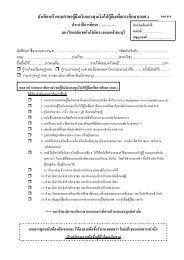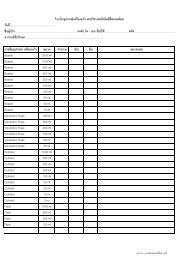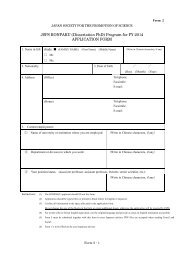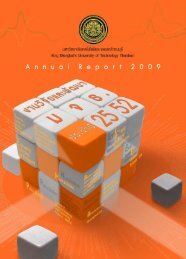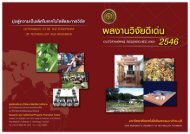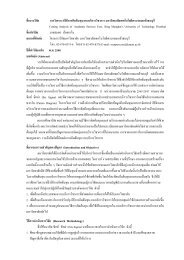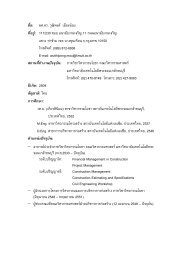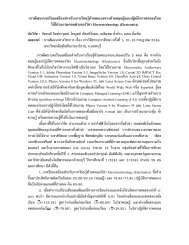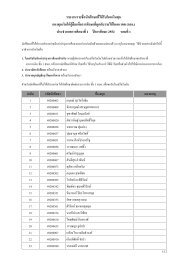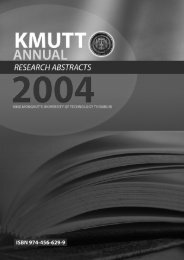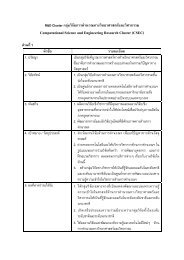You also want an ePaper? Increase the reach of your titles
YUMPU automatically turns print PDFs into web optimized ePapers that Google loves.
KMUTT Annual Research Abstracts 2005<br />
linearity arising from axial force. The non-linear<br />
eigenvalue problem is solved by the direct<br />
iteration method to obtain the beam’s non-linear<br />
frequencies and corresponding mode shapes for<br />
specified vibration amplitudes. We also present<br />
changes in the frequency of vibration as a<br />
function of amplitude, demonstrating the beam<br />
non-linearity. A more accurate solution analyzed<br />
in the frequency domain of the direct<br />
numerical integration method is adopted as an<br />
alternative solution. Large amplitude vibration<br />
experimental modal analysis was also conducted<br />
to complement the analytical results. The<br />
measured results were found to be in good<br />
agreement with those obtained from two<br />
analytical solutions.<br />
IJ-024 LARGE DEFLECTIONS OF VARIABLE-<br />
ARC-LENGTH BEAMS UNDER UNIFORM<br />
SELF WEIGHT: ANALYTICAL AND<br />
EXPERIMENTAL<br />
Tawich Pulngern, Marvin W. Halling,<br />
Somchai Chucheepsakul<br />
Structural Engineering and Mechanics, Vol. 19,<br />
No. 4, 2005, pp. 413-423<br />
This paper presents the solution of large<br />
static deflection due to uniformly distributed self<br />
weight and the critical or maximum applied<br />
uniform loading that a simply supported<br />
beam with variable-arc-length can resist. Two<br />
analytical approaches are presented and<br />
validated experimentally. The first approach is a<br />
finite-element discretization of the span length<br />
based on the variational formulation, which<br />
gives the solution of large static sag deflections<br />
for the stable equilibrium case. The second<br />
approach is the shooting method based on an<br />
elastica theory formulation. This method gives<br />
the results of the stable and unstable equilibrium<br />
configurations, and the critical uniform loading.<br />
Experimental studies were conducted to<br />
complement the analytical results for the stable<br />
equilibrium case. The measured large static<br />
configurations are found to be in good<br />
agreement with the two analytical approaches,<br />
and the critical uniform self weight obtained<br />
experimentally also shows good correlation with<br />
the shooting method.<br />
IJ-025 NONLINEAR FREE VIBRATIONS OF<br />
MARINE RISERS/PIPES TRANSPORTING<br />
FLUID<br />
Sakdirat Kaewunruen, Julapot Chiravatchradej,<br />
Somchai Chucheepsakul<br />
Ocean Engineering, Vol. 32, No. 3-4, 2005,<br />
pp. 417-440<br />
An investigation emphasizing on<br />
nonlinear free vibrations of marine risers/pipes<br />
to determine the nonlinear natural frequencies<br />
and their corresponding mode shapes is<br />
presented in this paper. Based on the virtual<br />
work-energy functional of marine risers/pipes,<br />
the structural model developed consists of the<br />
strain energy due to axial deformation, strain<br />
energy due to bending, virtual works due to<br />
effective tension and external forces, and also<br />
the kinetic energy due to both the riser and the<br />
internal fluid motions. Nonlinear equations of<br />
motion coupled in axial and transverse<br />
displacements are derived through the Hamilton's<br />
principle. To analyze the nonlinear free<br />
vibrational behaviors, the system formulation<br />
has been reformed to the eigenvalue problem.<br />
The nonlinear fundamental frequencies and the<br />
corresponding numerically exact mode shapes<br />
are determined by the modified direct iteration<br />
technique incorporating with the inverse<br />
iteration. The significant influences of the<br />
marine riser's parameters studied on its nonlinear<br />
phenomena are then illustrated here first. Those<br />
parameters demonstrate the nonlinear effects due<br />
to the flexural rigidity, top tensions, internal<br />
flow velocities, and static offsets.<br />
11<br />
IJ-026 VEHICULAR BASIC NOISE MODEL<br />
WITH 20 SECONDS OF EQUIVALENT SOUND<br />
LEVEL<br />
Pichai Pamanikabud, Marupong Tansatcha<br />
IASME Transactions, Vol. 2, No. 5, July 2005,<br />
pp. 769-773<br />
Basic noise model of vehicle is the<br />
primary parameter in the analysis and modeling<br />
of the main highway noise forecasting model.<br />
The model represents noise level with respect to<br />
its speed that created by each type of vehicle as<br />
the traffic noise source running on the highway<br />
section. The objective of this study is to<br />
analyzed and develop the basic noise model that<br />
can be effectively used for each vehicle type in<br />
Thailand. The novel technique of equivalent<br />
sound level measurement in the time period of<br />
20 second-L eq (20s) is employed in this study.<br />
Nine vehicle types on highways in Thailand are<br />
under the investigation. The L eq (20s) can cover<br />
the range of noise levels of all vehicle types<br />
International Journal



